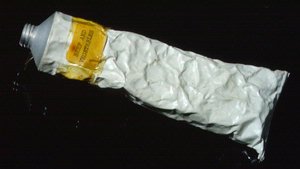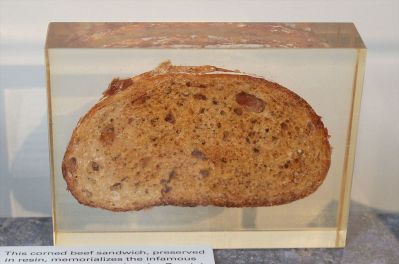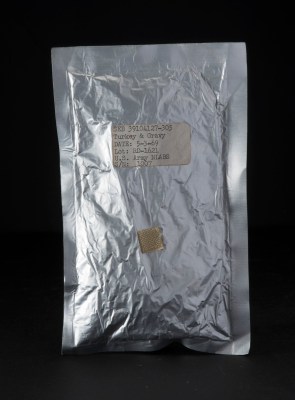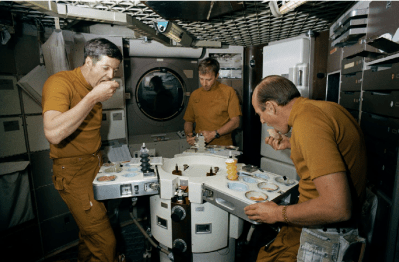When it comes down to it, we humans have two major concerns when venturing away from home for an extended period of time: what we’ll eat, and where we will sleep. Depending on the mode of travel, you might take some snacks along, or else rely on restaurants and/or the pantry of your possible hosts. Until the day we can reliably grow many types of food in space, or that Milliways, that five-star eatery at the end of the universe is operational, astronauts and other space-bound travelers will have to bring most of their food with them.
Cubes and Tubes
Space food has its roots in military rations, which in the United States were devised during the Revolutionary War. Both the variety and delivery methods of food have changed significantly since the beginning of the space program. While the menu may have at first been limited to tubes of nutrient-rich goo, bite-sized cubes and freeze-dried powdered beverages, the fare is more far-out these days. Astronauts on the ISS even enjoy tortillas, fresh fruits, and vegetables thanks to resupply missions, though they have to eat some of these types of foods quickly.
The average astronaut has also changed quite a bit, too. At first, they were all young and super-fit ex-military men, but nowadays they are more likely to be middle-aged science-y types and women. All three of these groups have different nutritional needs when faced with the rigors of living and working in space.
Space Erases Taste, and Things Don’t Stay In Place

Aside from the occasional bout of gastrointestinal distress, many of us take for granted the ease with which we eat and digest food here on Earth. Early on, scientists were unsure whether astronauts would be able to digest and absorb nutrients, or even swallow food at all in zero or microgravity.
The point is to keep the astronauts alive, obviously, but also to provide good nutrition through their favored foods whenever possible. The problem with space is that there is no gravity to pull bodily fluids downward, so everything flows evenly throughout the head and torso. This results in a congested head feeling, complete with a diminished sense of taste.
They knew at the outset that space foods and beverages had to check a few boxes; everything must be lightweight, palatable, nutritious, and not particularly perishable. It also has to survive the trip into space, including the temperature changes, vibrations, and various gases along the way.
In addition to physiological considerations, there are zero-gravitational considerations for preparing the food, packaging it, and then actually eating the stuff without it floating everywhere and gumming up the instruments.
Of Tubes and Tang

One of Yuri Gagarin’s assignments aboard Vostok 1 was to try eating something so that the Soviet scientists could study the effects on the first human to eat in space. Yuri slurped from three tubes using a straw: two of them had puréed meat, and the third was full of chocolate sauce. Later that year on Vostok 2, Gherman Titov earned the title of first person to vomit in space, making it clear that better nutrition was necessary.
John Glenn was the first American to eat in space while aboard Friendship 7 in 1962, and he did so armed with a metal tube of pureed beef and vegetables and another full of applesauce. Here’s a fun fact: Tang was not invented for astronauts. It was available to consumers a few years before Mr. Glenn famously drank some in space, however it did not sell well until that event. You might say that sales skyrocketed afterward.
Just Add Water
Freeze-dried foods were introduced during the Gemini program to supplement the dehydrated and bite-sized offerings. These were coated with either oil or gelatin to keep them from crumbling. Everything was vacuum-packed into four-ply laminated packages with a port at one end for injecting water sourced from the hydrogen-oxygen fuel cells.

A typical Gemini meal included a beef sandwich, peaches, strawberry cereal cubes, and a packet of beef and gravy. In spite of this tempting fare, astronaut John Young snuck a corned beef on rye aboard to surprise Gus Grissom, who loved them.
As you might imagine, bread crumbs started floating as soon as he pulled it out of his space suit pocket, so he put it away soon after. This incident did not go unnoticed by NASA, who gave Young a slap on the wrist and then tightened up the list of what astronauts could bring along with them.
The 1966 film embedded below was shot at Natick Army Laboratory, who developed food for the Apollo program. It explores the establishment of a baseline for nutrition through rigorous testing that researchers hoped was an exaggeration of what astronauts would experience during space travel.
Chow Time On the Apollo

The Apollo program saw significant changes in food packaging and near-constant menu expansion in an effort to keep the astronauts healthy and happy. User feedback was a major catalyst for change. All of the astronauts’ meals were almost identical on the early missions, but by the time they launched Apollo 17, the meals were highly individualized for each person.
Making Spirits Bright
Occasionally, they would even get a special treat. On Christmas Eve 1968, the Apollo 8 astronauts were surprised to find pouches of thermostabilized turkey with gravy and cranberry sauce that didn’t have to be reconstituted. And for the first time, they ate with spoons. The resulting boost in morale made this weight increase justifiable for future missions, and the wetpack was born.
It was around this time that NASA really started to consider individual preferences when devising recipes. A woman named Rita Rapp developed a spoon-bowl package that allowed astronauts to enjoy a more Earth-like eating experience.
Here is a complete overview of the Apollo Food Technology program, which was the inspiration for this post. It has detailed information about all the foods the astronauts ate during the Apollo program, including full menus from each mission. It is also a nice exploration of the development of space-worthy foodstuffs and the constraints of same.
Skylab’s the Limit
Skylab, the first US space station that was built out of Apollo parts, sounds like it was the height of weightless dining luxury. There was a galley, a table, and each crew member’s tray contained heating elements.
There weren’t too many dehydrated foods on Skylab,

because it ran on solar cells instead of water-producing fuel cells. Many of the foods were stored in plastic pouches and aluminum cans with pop tops.
Skylab also had a small refrigerator/freezer and for the first time, astronauts ate real ice cream. By the way, freeze-dried ice cream isn’t real astronaut food. Although the stuff was developed for NASA and even appears in the Apollo 7 press kit (PDF, page 83), it has never flown into space, only off of the shelves of gift shops.
Eating Aboard the ISS
As astronauts spend longer and longer periods in space, the need for tasty and nutritious food only grows more important. Today, astronauts visit the NASA test kitchen first to help plan the menus before their trip to space. They enjoy everything from fresh fruits to spaghetti to beef jerky depending on preference. However, since the food continues to taste bland because of the congestion caused by weightlessness, the most popular items in the pantry are the salt, the pepper, and the hot sauce.
In the video below, astronaut Chris Hadfield makes a peanut butter and honey sandwich in space. If you’re still hungry for more, check out this longer video about eating aboard the ISS in general.
The ISS doesn’t get absolutely everything delivered, food-wise. Since 2002, they’ve been growing food inside a couple of small greenhouses. Not only does this supplement their diet, science gains insight into how food can be grown in space.
And then there’s forbidden food made in space. Remember when they had to bake cookies and send them back to Earth without eating any?
















Gemini fuel cells did not produce potable water. The water from the Gemini fuel cells was the color of strong tea and had an odor and floating particles the crew called “furries”. Gemini crew used a separate supply of water brought from the ground to re-hydrate their food.
Humans are absolutely not adapted to very low gravity environments. Eventually we will make workarounds and solutions on the cellular level but for now, we just have to mess around with making things more Earth-like.
Yep, we’ve been spoiled by 4 billion years of gravity.
Very interesting article !
Kurbrick’s 2001 brought some ideas about space food and artificial gravity.
NASA astronauts have been eating vegetables they’ve grown on the International Space Station since 2015. The quantities are small, but they’ve grown lettuce and a variety of other salad crops, plus radishes and (most recently) chilli peppers.
“I once grew a watermelon in a cardboard box. It came out square”.
James Holden, The Expanse. About series 2 or 3.
Seems to be lots of water out there – algae
Anyone else notice the big bag of weed? I suppose if you are going to get spaced out it’s the place to do it.
It was spinach